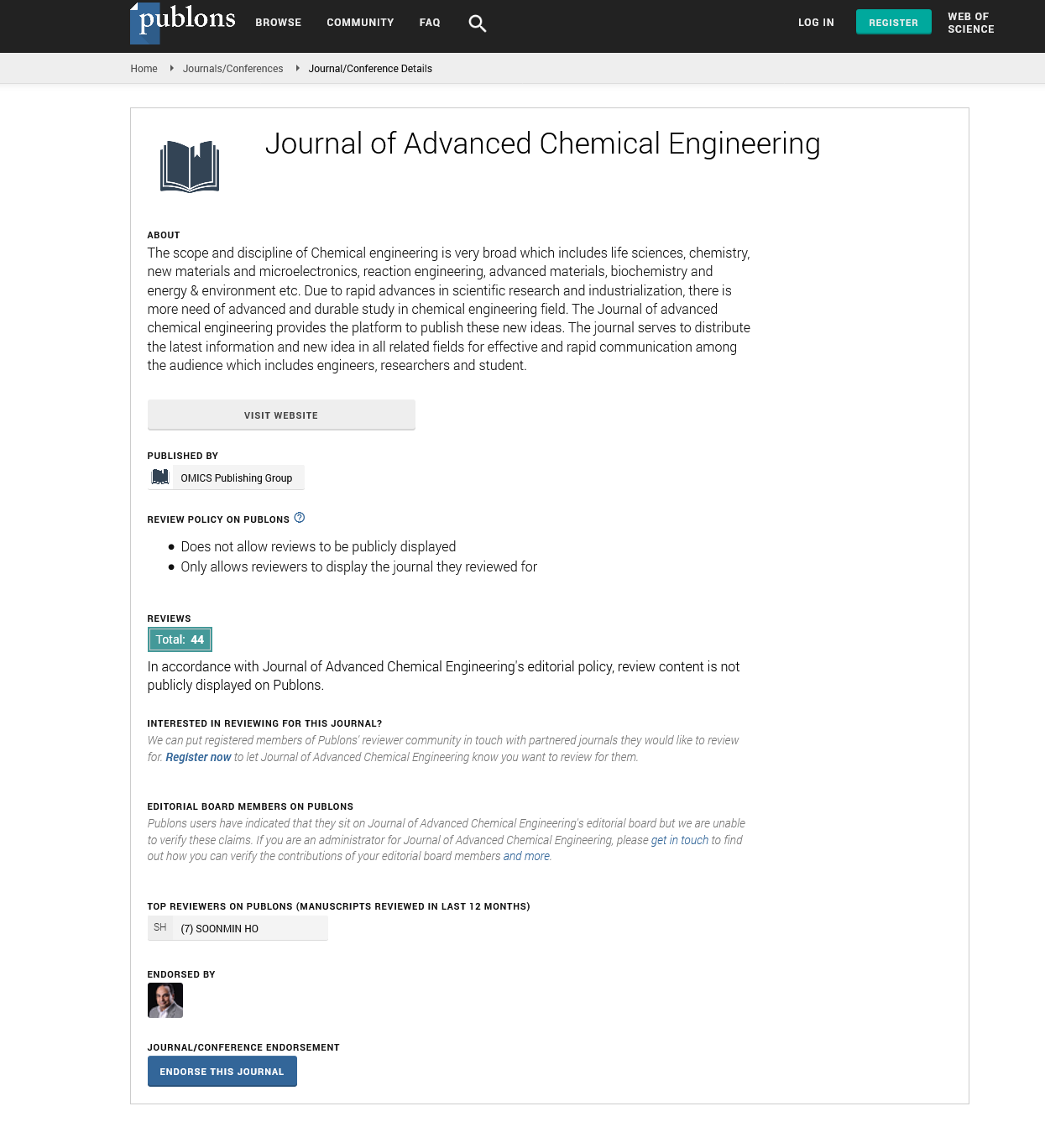Indexed In
- Open J Gate
- Genamics JournalSeek
- Smithers Rapra
- RefSeek
- Directory of Research Journal Indexing (DRJI)
- Hamdard University
- EBSCO A-Z
- OCLC- WorldCat
- Scholarsteer
- Publons
- Geneva Foundation for Medical Education and Research
- Google Scholar
Useful Links
Share This Page
Journal Flyer

Open Access Journals
- Agri and Aquaculture
- Biochemistry
- Bioinformatics & Systems Biology
- Business & Management
- Chemistry
- Clinical Sciences
- Engineering
- Food & Nutrition
- General Science
- Genetics & Molecular Biology
- Immunology & Microbiology
- Medical Sciences
- Neuroscience & Psychology
- Nursing & Health Care
- Pharmaceutical Sciences
Short Communication - (2023) Volume 13, Issue 3
Chemical Plant and it's Design, Operation, and Safety
Wong Yin*Received: 02-Jun-2023, Manuscript No. ACE-23-22081; Editor assigned: 05-Jun-2023, Pre QC No. ACE-23-22081 (PQ); Reviewed: 19-Jun-2023, QC No. ACE-23-22081; Revised: 26-Jun-2023, Manuscript No. ACE-23-22081(R); Published: 03-Jul-2023, DOI: 10.35248/2090-4568.23.13.287
Description
A chemical plant is a complex industrial facility where chemical processes are conducted on a large scale to transform raw materials into desired products. Chemical plants encompass a wide range of industries, including petrochemicals, pharmaceuticals, polymers, fertilizers, and specialty chemicals. Understanding the key aspects of chemical plants is vital for ensuring efficient production, minimizing environmental impact, and maintaining the safety of personnel and surrounding communities.
Design of chemical plants
The design of a chemical plant involves the integration of various elements, including process design, equipment selection, layout, utilities, and infrastructure. The design process starts with process engineering, where the desired chemical reactions and transformations are identified, and the optimal process flow scheme is developed. Process engineers use principles of chemical kinetics, thermodynamics, and transport phenomena to determine the appropriate reactor types, separation methods, and process conditions.
Equipment selection is a vital step in plant design, involving the choice of reactors, heat exchangers, pumps, compressors, distillation columns, and other equipment. Factors such as equipment capacity, materials of construction, operating conditions, energy efficiency, and maintenance requirements are considered during the selection process.
Layout design involves determining the spatial arrangement of equipment, storage tanks, piping systems, and utility connections. Considerations such as safety, accessibility, process flow optimization, and future expansion are taken into account. Proper layout design ensures efficient material and personnel flow, minimizes operational bottlenecks, and facilitates maintenance and troubleshooting.
Operation of chemical plants
The operation of a chemical plant involves the day-to-day management of the facility to ensure safe and efficient production. Key aspects of plant operation include process control, monitoring, maintenance, and optimization.
Process control is vital for maintaining the desired operating conditions, product quality, and safety. It involves the use of instrumentation, sensors, control valves, and automation systems to monitor and regulate process variables such as temperature, pressure, flow rates, and composition.
Continuous monitoring of process parameters and product quality is essential to detect deviations, ensure compliance with specifications, and prevent safety incidents. Online analyzers, sampling systems, and laboratory testing are used to monitor and analyze process streams and products. In addition, process safety systems, including emergency shutdown systems, relief valves, and alarms, are implemented to protect against potential hazards and respond to abnormal conditions.
Safety considerations in chemical plants
Safety is of predominant importance in chemical plants due to the potential hazards associated with handling and processing hazardous substances. Safety considerations encompass process safety, occupational health and safety, and environmental protection. Process safety focuses on preventing and mitigating the consequences of major accidents, such as fires, explosions, and toxic releases. It involves hazard identification, risk assessment, and the implementation of preventive and protective measures. Process hazard analyses, such as HAZOP (Hazard and Operability Study) and LOPA (Layers of Protection Analysis), are conducted to identify potential hazards and establish safeguards. Safety management systems, emergency response plans, and training programs are developed to ensure preparedness and effective response in case of emergencies.
Conclusion
Chemical plants play a vital role in producing a wide range of chemicals and materials. The design, operation, and safety considerations of chemical plants are essential for ensuring efficient production, maintaining product quality, protecting the environment, and safeguarding the well-being of workers and communities. By incorporating sound engineering principles, advanced control systems, effective maintenance practices, and robust safety measures, chemical plants can operate reliably, optimize performance, and contribute to sustainable development.
Citation: Yin W (2023) Chemical Plant and it’s Design, Operation and Safety. Adv Chem Eng. 13:287.
Copyright: © 2023 Yin W. This is an open-access article distributed under the terms of the Creative Commons Attribution License, which permits unrestricted use, distribution, and reproduction in any medium, provided the original author and source are credited.

